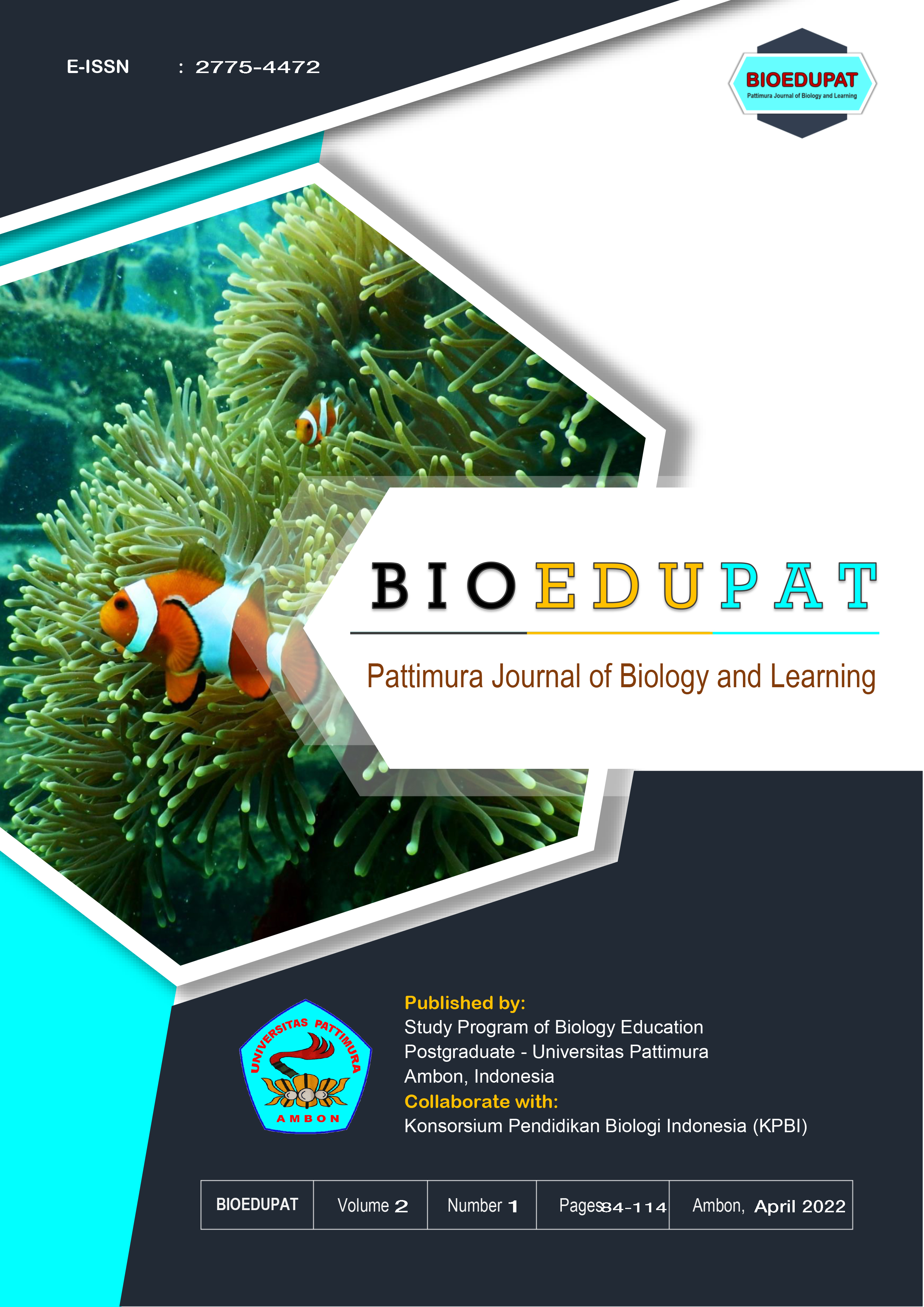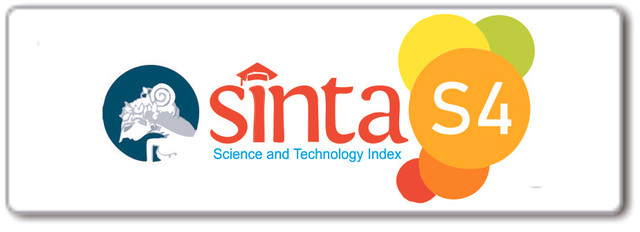Density and morfometric analysis of sia-sia (Sipunculus nudus) from Nusalaut island beach waters central Maluku
Abstract
Sia-sia (Sipunculus nudus) has a shape resembling a worm, is an organism that usually lives in coastal areas, especially around seagrass areas, this biota tends to inhabit the bottom of the water especially in the substrate so that it is categorized as an infauna benthic organism and is able to inhabit areas with soft and hard substrates. This is a deskriptive type of research, to describe or describe information about the density and morphometrics of Sia-sia from the coastal waters of Nusalaut Island, Central Maluku. The results of the study on the density of Sia-sia on the island of Nusalaut, differ according to location, based on the results of the density calculation obtained. Each location shows the total average value of Absolute Density (KA) is 0,0063 ind/m2 (Low) and Relative Density (KR) is 100%. The Absolute density level (KA) in Abubu Vilage is 0,0068 ind/m2 (Low), the absolute density level (KA) in Ameth Villlage is 0,0064 ind/m2 (Low) and the absolute density level (KA) in Akoon Village is 0,0058 ind/m2 (Low), Based on the results of the Sia-sia morphometric research from Nusalaut Island, the Results vary from each village with Sia-sia morphometric average length of 12,14 cm, width 2,15 cm and weight of 31,6 g, followed by Akoon village with Sia-sia morphometric average length of 11.6 cm, width 2,21 cm, and a weight of 33,6 g, and the last one is Ameth Village with an average length of Sia-sia morphometric that is 13,02 cm, width 2,26 cm, and weight 36 g
Downloads
References
Ardean.S.D., R.M.S. Putridan M. Suhandana. 2018. Measurement of yield, morphometric and proximate composition of the characteristics of the caterpillar (Sipunculus Nudus) from Bintan waters. fishery product technology study program, Faculty of marine and fishery sciences, Raja Ali Haji maritime university.
Ager, O. 2004, Aquaculture, the marine life information. Network for Britain and Ireland.
Bengen, D.G. 2001. Synopsis of coastal ecosystems and natural resources. Bogor Agricultural Institute: center for the study of coastal and marine resources.
Culter, E. B. 1994. The Sipuncula: Their systematic, biology and evolution. Cornell Univ. Press Ithaca, N. Y: 453 pp.
Doherrty, D., McCarthy, TK, 2004. Morphometric and Meristic characteristics analyzes of two western Iris Populations of artic char, Salvelinus alpinus (1). journal of biology and Environment: proccedings of The Royal Irish Academy. 104b(1):75-85
Haryono. 2001 Variations in morphology and morphometry of dokun fish (Puntius lateristriga) in Sumatra. Journal of Biota (1) (3) 109-116.
Hearling, R. 2001. Morphometric studies and food preferences of luligo edulis caught with a "scoop net" in mahia waters on the island of Ambon.
Hynes, H. B. N. (1976). The ecology whit Of Running Water. Liverpool University Press, England.
Krebs, C.J. (1978). Ecology of Experimental Analysis of Distribution and abundance. Second edition. New York: Harper and Row publishers.
Langer, S., Triphati., Khajuria. 2013. Morphometric and Meristic Study of Golden Mhaser (tor putitora) from jhajar strem India. journal of Animal verterinary and Fhishery Sciences.1(7): 1-4.
Mardiana. 2011. Characteristics of fatty acids and cholesterol of crab (Portunus pelagicus) due to the steaming process. [thesis]. Bogor: Faculty of Fisheries and Marine Sciences, Bogor Agricultural University.
Nursaiful, A. 2004. Marine Aquarium. Self-Help Spreader. Depok.
Nontji, A. 2009. Rehabilitation of seagrass ecosystems in coastal resource management. National Workshop I for Seagrass Ecosystem Management. 18 November 2009. Jakarta, Indonesia.
Odum, E. P. (1999). Ecology basics. Gadjah Mada University Prees. Yogyakarta.
Parker R. 2012. Aquaculture Science. New York: Delmar.
Pamungkas J. 2010. Sipuncula: A controversial marine biota. Oceana Journal. 35(1): 7-10. B
Riniatsih, 2009. Basic Substrate and Oceanographic Parameters as Determinants of the Presence of Gastropods and Bivalves in Determining the Presence of Gastropods and Bivalves on Sluke Beach, Rembang Regency. Journal of Marine Science, Department of Marine Science, Faculty of Fisheries and Marine Science, Diponegoro University, Tembalang Campus, Semarang.
Rukminasary N., Nadiarti & Awaludin K. (2014). The effect of the degree of acidity (pH) of seawater on the concentration of calcium and growth rate of Halimeda sp. Torani (Journal of Marine and Fisheries Science). 24(1): 28-38.
Romimohtarto, K. and Juwana, K. (2009). Marine Biology. Jakarta : Bridge.
Sary, 2006. Lecture Materials on Water Quality Management. Vedca Polytechnic. Cianjur.
Silaban B, 2012. Chemical composition and utilization of “wasted” sea worms consumed by the people of Nusalaut Island, Central Maluku.Jurnal Triton (2): 1-9
Silaban, R. 2019. Studies on ethnotechnology and the use of waste (sipunculus nudus) of people on the island of Nusalaut, Central Maluku district.
Tree of Life Web project. 2008. Sipuncula. Peanut worms. january 09 2008 (temporary), http;//tolweb.org/sipuncula/2487/2008..
Trueman, E.R. Foster-Smith, R.L (2009).” The mechanism of brouwing of Sipunculus nudus”. Journal of zoology.
Turan, C. 1998. A Note on The Examination of Morfometric Deference Among Fish Populations: The Truss System. Journal of The University of Mutafa Kemal, Faculty of Fhisheries, Hatay-Turkey
Tzen. T-D., Chiu, C-S., Yeh, S-Y. 2000. Morphometric Variation in Red-Spot Prawn (Metapenaeopisis barbata) in Different Geographic Waters of Taiwan. Institute of Oceanography, National Taiwan University, Taipei 106, Taiwan ROC. Journal of Fisheries Research 53 (2001) 211-217
Zhang C. X., Zi R. D, Qiu X. C. 2011. Anti-inflammantory and anti-nonciceptive activities of Sipunculus nudus L. extract. Journal of Ethnophrmacology. 137(1)1177-1182.
Copyright (c) 2022 Adrianus Ferdinandus, Sintje Liline, Syahran Wael

This work is licensed under a Creative Commons Attribution-NonCommercial-ShareAlike 4.0 International License.
Authors who publish with BIOEDUPAT: Pattimura Journal of Biology and Learning agree to the following terms:
- Authors retain copyright and grant the journal right of first publication with the work simultaneously licensed under a Creative Commons Attribution License (CC BY-NC-SA 4.0) that allows others to share the work with an acknowledgment of the work's authorship and initial publication in this journal.
- Authors are able to enter into separate, additional contractual arrangements for the non-exclusive distribution of the journal's published version of the work (e.g., post it to an institutional repository or publish it in a book), with an acknowledgment of its initial publication in this journal.
- Authors are permitted and encouraged to post their work online (e.g., in institutional repositories or on their website) prior to and during the submission process, as it can lead to productive exchanges, as well as earlier and greater citation of published work.









 This work is licensed under a
This work is licensed under a 